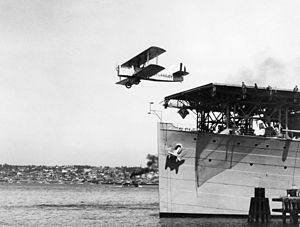- Douglas DT
-
DT Douglas DT-2 launched from U.S.S. Langley, San Diego, California Role Torpedo bomber Manufacturer Douglas Aircraft Company First flight November 1921 Primary user United States Navy Produced 1921-1929 Number built 90 Variants Douglas World Cruiser The Douglas DT bomber was the Douglas Aircraft Company's first military contract, forging a link between the company and the United States Navy. Navy Contract No. 53305 of April 1, 1921, required only 18 pages to set out the specifications that resulted in the purchase of three DT (D for Douglas, T for torpedo) folding-wing aircraft.
The DT used a welded-steel fuselage with aluminum covering the forward and center sections and fabric covering the rear section. Douglas built 46 DT-1 and DT-2 torpedo bombers for the U.S. Navy, Norwegian Navy, and Peruvian Navy. 20 DT-2 aircraft were built under license by Lowe-Willard-Fowler Engineering Company, six by the Naval Aircraft Factory, and 11 by Dayton Wright Company. Another seven were built for Norway under license by Marinens Flyvebåtfabrik. Although still in service when the Germans invaded Norway, the Norwegian DTs did not see action in the Norwegian Campaign. The DT could be fitted either with pontoons or wheeled landing gear and could carry a 1,800 lb (816 kg) torpedo.
First flight was in November 1921 and production continued until 1929. The DT operated off the U.S. Navy's first aircraft carrier, USS Langley, from land bases, and from seaplane tenders. Several were flown by the Marine Corps.
Variations of the DT-2 aircraft were designated DT-4, DT-5, DT-6, and DTB. Machines licence-built by Dayton-Wright were internally designated SDW by that company. The type became the basis for the Douglas World Cruiser.
Contents
Variants
- DT-1
- Pre-production prototypes; three built.
- DT-2
- Two-seat torpedo-bomber biplane, powered by a 450-hp (336-kW) Liberty V-12 piston engine; 64 built.
- DT-3
- Proposed version of the DT-2. Not built.
- DT-4
- Four DT-2s converted into bomber aircraft by the Naval Aircraft Factory. The aircraft were fitted with direct drive Wright T-2 V-12 engines.
- DT-5
- Redesignation of two DT-4s fitted with a geared 650-hp (523-kW) Wright T-2B V-12 engines.
- DT-6
- One DT-2 aircraft fitted with a 450-hp (336-kW) Wright P-1 radial piston engine.
- DT-2B
- This designation was given to one DT-2 aircraft suppiled to the Norwegian government. Seven similar aircraft were built under licence in Norway.
- DTB
- Export version for Peru. Four aircraft built for the Peruvian navy, fitted with 650-hp (523-kW) Wright Typhoon V-12 piston engines.
- SDW-1
- Redesignation of three DT-2s modified by the Dayton-Wright company.
Operators
- Navy of Peru
Specifications (DT-2)
General characteristics
- Crew: two, pilot and gunner
- Length: 37 ft 8 in (11.5 m)
- Wingspan: 50 ft 0 in (15.8 m)
- Height: 15 ft 1 in (4.6 m)
- Wing area: 707 ft² (65.7 m²)
- Empty weight: 4,528 lb (2,054 kg)
- Loaded weight: 7,293 lb (3,308 kg)
- Powerplant: 1 × Liberty, 450 hp (336 kW)
Performance
- Maximum speed: 100 mph (160 km/h)
- Range: 274 mi (441 km)
- Service ceiling: 7,400 ft (2,300 m)
- Rate of climb: 14.5 min to 5,000 ft (14.5 min to 1,500 m)
- Wing loading: 10.3 lb/ft² (50.4 kg/m²)
- Power/mass: 16.2 lb/hp (9.92 kg/kW)
Armament
- 1 × .30 in (7.62 mm) Browning machine gun
- 1 × 1,835 lb (834 kg) aerial torpedo
See also
- Related development
- Douglas World Cruiser
References
- René Francillon, "McDonnell Douglas Aircraft Since 1920: Volume I", ISBN 0-87021-428-4
USN/USMC torpedo aircraft designations pre-1962 Torpedo CTTEFTGreat LakesStoutSTTorpedo Bomber Great LakesTBGTBVPatrol Torpedo Bomber HallTorpedo Scout Douglas military aircraft Fighters Ground attack Naval bombers
and attack aircraftBombers Observation Patrol PD · P2D · P3D
Reconnaisance Transports C-1 · C-21 · C-32 · C-33 · YC-34 · C-38 · C-39 · C-41 · C-41A · C-42 · C-47 · C-48 · C-49 · C-50 · C-51 · C-52 · C-53 · C-54 · C-58 · UC-67 · C-68 · C-74 · C-84 · C-110 · XC-112/YC-112 · XC-114 · YC-116 · C-117 · C-118 · C-124 · YC-129 · C-133 · XCG-17
C-9 · C-24
RD · R2D · R3D · R4D (R4D-2 & R4D-4) · R5D · JD · R6D
CC-129 · Dakota I/III/IV · Dakota II · LXD1 · PD.808 · Skymaster ITraining aircraft Experimental Aircraft produced by Dayton-Wright Aerial Coupe • Bug • Cabin Cruiser • Chummy/TA-3/TA-5/TW-3 • FP.2 • FS • Messenger • Racer • SDW • USXB-1 • WS • XO-3 • XPS-1
Lists relating to aviation General Aircraft (manufacturers) · Aircraft engines (manufacturers) · Airlines (defunct) · Airports · Civil authorities · Museums · Registration prefixes · Rotorcraft (manufacturers) · TimelineMilitary Accidents/incidents Records Categories:- Propeller aircraft
- United States bomber aircraft 1920–1929
- Biplane aircraft
- Torpedo bombers
- Douglas aircraft
- Single-engine aircraft
Wikimedia Foundation. 2010.


